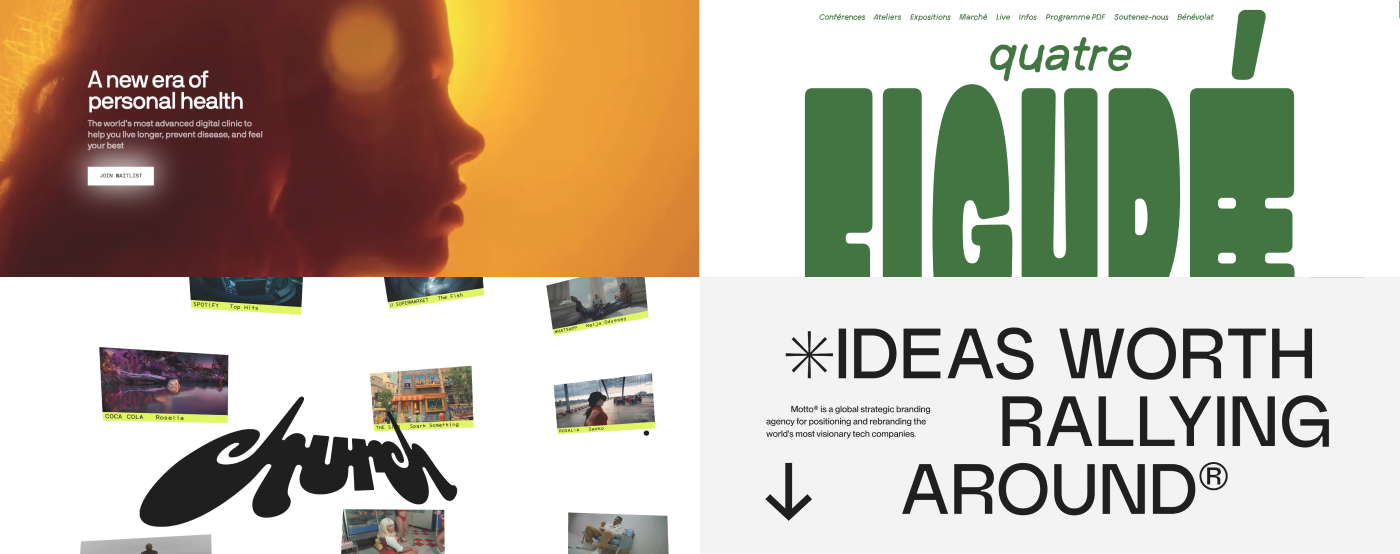Top 5 UI & UX Design Trends in 2025
Presenting the user experience trends shaping 2025 — from pushing the boundaries of minimalism to the real-life implementation of AI in the design process. With 2024 long forgotten, the future of UX design is here! UI and UX enthusiasts, are you ready for these exciting UX design trends?

Typography is the new 2025 UI storyteller
In 2025, minimalism will reach new extremes, with typography taking center stage. Expect even more white space and creative typography: combining various fonts and basing the entire UI around the text. In some cases, typography might even overshadow illustrations, photos, and videos.
Typography is becoming self-sufficient content. It's no longer just about providing information — now it's in charge of the entire storytelling process.
Check out examples of brands that are not afraid to put typography in the center:


Big jump into design motion
Don’t expect a crazy UX rollercoaster on the UI front. Yes, there will be an even bigger push for motion and dynamic elements on websites and applications, but it means that even more “conservative” brands will adopt motion to show that their websites are breathing with full lungs (virtually, at least).
Microinteractions are at the center of this trend — those little tweaks, jumps, and other design elements that help create a user-centered experience. What’s fascinating about it is how perfectly it aligns with minimalism. Just check it out for yourself!
Get inspired to design in motion with these websites:
Mitchell Eaton, purposeful motion designer

Superpower healthcare platform

Throwing away top UX conventions
Some websites will embrace this trend, primarily those representing artistic brands that dare to venture into more extreme UI territories. UX/UI designers working with these brands will officially toss aside the “Don’t Make Me Think” rules, focusing on one goal: surprising the user. Forget template interfaces, UX best practices, and past design trends — every means to an end is allowed, even if that “end” results in a user interface that isn’t entirely clear.
Keep in mind, though, that this UX trend isn’t for every UX designer. Only edgy, artistic brands can afford to have fun with UI and play a dangerous game with their users like that. The late months of 2025 will reveal whether these design decisions truly pay off.
Simmonds Ltd, an art direction studio

Church, film editors congregation

AI-Powered workflow management
Naturally, there’s no escaping AI. Product designers will increasingly rely on artificial intelligence to support their daily work. This means the natural growth of AI plugins, and AI features in design tools.
Figma AI plugins
Plugins have always been a collaborative powerhouse in Figma, so we want to showcase some examples of plugins that are becoming essential in the daily workflow of product designers.
Examples of Figma AI plugging worth trying:
-
Content Reel streamlines your design workflow by providing dynamic placeholder content. It allows you to quickly insert text, avatars, icons, and other elements directly into your designs. With customizable options and a simple interface, Content Reel helps designers maintain realistic mockups without spending time searching for filler content.
-
It allows you to apply and manage styles in bulk across your design projects. Whether you're working with text, colors, or effects, Batch Styler simplifies the process by letting you update multiple elements simultaneously.
AI-powered wireframes
At this moment, AI is not yet capable of generating fully functional wireframes from scratch, but that could change in the coming months. Additionally, copyright laws still need to catch up to clarify whether AI-generated wireframes can be used commercially without legal concerns.
Despite these limitations, AI-generated wireframes offer several benefits. They can help overcome the fear of a blank page, providing product designers with a starting template to build upon. These wireframes also serve as valuable tools for early-stage product testing, making the creation of initial designs more cost-effective and efficient.
Check out an example of an AI-powered wireframe of a live sports score application:

AI wireframes definitely have potential, but it’s still hard to say if we should be excited about that. Why? AI-powered wireframes often tend to look too similar. Do we really want all our websites and software products to share the same generic UI? We would still put our money on personalization.
Figma's AI Features
Beyond plugins, Figma offers built-in AI-powered features that streamline workflows. These tools help you save time and effort in various ways. You can generate images, search for similar components across all your Figma pages, translate content, and more. As we move into 2025, Figma is likely to introduce even more of these small yet powerful enhancements, making design faster than ever.

AI for UX writing
How often do you find yourself ready to dive into design, only to be stuck waiting for the copy? Soon, that frustration might be a thing of the past.
AI is set to play a pivotal role in crafting copy for user interfaces. While still supervised by UX writers, it can generate text for multiple screens of applications or websites, ensuring consistency across the board.
Gamification: an even bigger UX trend in 2025
User engagement through gamification is well-known, especially in industries like sports and fitness technology or educational platforms. Duolingo is a prime example. But what about other industries? Should they incorporate gamification into their design processes? Absolutely — product designers will need to do it! Gamification is a powerful tool to personalize user experiences and shape them in ways that build long-lasting bonds with users.
Examples of apps boldly embracing gamification:
A unique app that encourages users to stay hydrated by combining health tracking with gamification. Every glass of water you drink helps nurture and grow a virtual plant in the app. The plants thrive as you meet your hydration goals, offering a fun and visual incentive to maintain healthy habits.
A creative finance management app that uses gamification to make budgeting fun and engaging. As you track your expenses, the app builds a thriving virtual city based on your financial habits.
Are you excited about 2025 predictions?
We are! 2025, don’t you dare bore us. 😎


